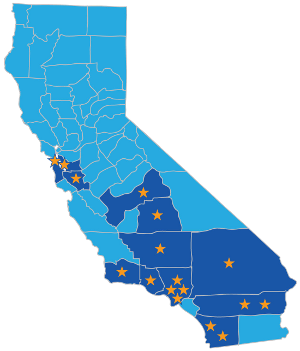Frequently Asked Questions
What is the Affordable Care Act?
What are the essential benefits all healthcare plans must cover?
Do I have to buy health insurance?
Who is eligible for insurance through Covered California?
When does the new health coverage begin?
What kind of health insurance will be offered?
What is catastrophic coverage?
How much will health insurance cost?
How is the Affordable Care Act making it easier to compare different plans?
What type of financial assistance is available?
Will I qualify for free insurance?
What is the Affordable Care Act?
The Affordable Care Act is a federal law that began full implementation on January 1, 2014. The new law creates protections and makes healthcare affordable.
The Affordable Care Act does 5 key things:
- Requires all healthcare plans to provide a set of essential benefits that include free preventive services, such as basic checkups, vaccinations, birth control, and life-saving cancer screenings.
- Creates healthcare marketplaces in each state that help individuals and families find affordable insurance and offers premium assistance to those who need it.
- It allows children to stay on their parents’ health plan until they are 26 – even it they are married or don’t live at home.
- Prohibits insurance companies from denying coverage due to a pre-existing medical condition.
- Prohibits insurance companies from charging for coverage based on your gender or medical history, or imposing a limit on medical care over a lifetime. They will also be required to spend at least 80% of your premium dollars, the money you pay for coverage, on your medical care instead of administrative costs.
[Back to Top]
What are the essential benefits all healthcare plans must cover?
Under the Affordable Care Act, all healthcare plans are required to cover:
- Ambulatory patient care
- Emergency service
- Hospitalization
- Maternity and newborn care
- Mental health and substance abuse disorder treatment
- Prescription drugs
- Rehabilitation and habilitation services and devices
- Lab services
- Preventive and wellness services and chronic disease support
- Pediatric services, including dental and vision care
Click here for a handout on these benefits.
[Back to Top]
Do I have to buy health insurance?
Starting in January 2014, most people will be required to have health insurance or pay a penalty if they don’t. Coverage may include employer-provided insurance, coverage someone buys on their own, Medicare or Medi-Cal.
In 2014, the penalty for not having health insurance will be 1 percent of your annual income or $95, whichever is greater. By 2016, the penalty will be 2.5 percent of your annual income or $695.
Some people do not have to enroll in health insurance or pay a penalty, including:
- People who would have to pay more than 8 percent of their income for health insurance
- People with incomes below the threshold required for filing taxes (in 2012, $9,750 for a single person and $27,100 for a married couple with two children)
- People who qualify for religious exemptions
- Undocumented immigrants
- People who are incarcerated
- Members of Native American tribes
[Back to Top]
What is Covered California?
Covered California is a new way that Californians can compare and shop for health insurance. You must use Covered California to receive income based premium assistance, like tax credits. At CoveredCA.com you will fill out one application to enroll in health insurance and check your qualification for Medi-Cal.
[Back to Top]
Who is eligible for insurance through Covered California?
- You must live in the U.S.
- You must be a U.S. citizen or national, or lawfully present
Even if you don’t qualify because you are not a U.S. citizen, other members of your family might be eligible for coverage. There is no penalty for applying, and your information will not be used for any purpose other than determining if you and your family members qualify for health coverage.
[Back to Top]
How can I enroll?
Enrollment in health plans will begin November 15, 2014 and continue until February 15, 2015. You must purchase health insurance during this open-enrollment period in order to obtain coverage in 2015. You can enroll:
- Online – www.coveredca.com
- By phone – 800-300-1506
- In person – Find your local Health center
- Using a paper application (mail or fax)
If you have a life-changing event such as the loss of a job, death of a spouse or birth of a child, you are eligible for special enrollment within 60 days of the event.
[Back to Top]
When does the new health coverage begin?
Coverage through the Covered California and Medi-Cal begins on January 1, 2015, as long as you have enrolled by December 15, 2014. After that, coverage will begin the first of each month as long as you have enrolled by the 15th of the previous month.
[Back to Top]
What kind of health insurance will be offered?
Covered California will offer Qualified Health Plans that are the same high-quality health plans available on the private market today from some of the most widely used companies like Anthem and Kaiser Permanente. These Qualified Health Plans are guaranteed to provide essential levels of coverage and consumer protections required by the Affordable Care Act. Plans will be offered in categories based on the percentage of covered expenses paid by the health plan.
[Back to Top]
What is catastrophic coverage?
In addition to traditional health plans, Covered California will offer what is called “catastrophic coverage,” which helps protect a person from financial disaster in the event of a serious and expensive medical emergency. Catastrophic coverage is not designed for day-to-day medical expense such as doctor visits, prescription medicines or even emergency room visits.
It is designed to cover excessive medical bills that occur above the limit that you would be able to manage financially. Covered California will provide catastrophic coverage to those up to age 30, or those individuals who can provide a certification that they are without affordable coverage or are experiencing hardship.
[Back to Top]
How is the Affordable Care Act making it easier to compare different plans?
There will be four basic levels of coverage: Platinum, Gold, Silver and Bronze. Every plan available at each level will cost the same price, but using this simple ranking system you can make apples-to-apples comparisons of different health plans to find the best option for your needs.
For more information about the basic levels of coverage, visit here.
[Back to Top]
How much will health insurance cost?
The cost of health insurance depends on the percentage of medical expenses that a health plan will cover. You can choose to pay a higher monthly cost so that when you need medical care, you pay less out-of-pocket. Or you can choose to pay a lower monthly cost so that when you need medical care, you pay more. Health plans that cover more of your medical expenses usually have a higher monthly payment but you pay less for medical care when you need it.
The cost of healthcare coverage also depends on if you qualify for tax credits or subsidies that will lower the premium you pay monthly for health insurance. To be eligible for financial assistance you must enroll for health insurance through Covered California. Find out who qualifies for tax credits or subsidies here.
The Covered California cost calculator can help you determine about how much you will pay for insurance coverage, including any financial assistance you qualify for.
[Back to Top]
What type of financial assistance is available?
Starting in 2014, individuals seeking health coverage will be helped to afford coverage in three ways:
- Tax credits: Tax credits are available to lower the cost of health coverage for individuals and families who meet certain income requirements and do not have health insurance from an employer or a government program. When you enroll in a health plan through Covered California, tax credits can be immediately applied to the insurance premium, which reduces the amount you pay each month. To find out more about tax credits, visit here.
- Cost-sharing subsidies: Cost-sharing subsidies reduce the amount of out-of-pocket health care expenses an individual or family has to pay. These expenses might include the copayments for health care services or other costs. To find out more about cost-sharing subsidies, visit here.
- Medi-Cal assistance: Starting in 2014, the State of California is planning to expand Medi-Cal to cover people under age 65, including people with disabilities, with income of less than $15,856 for a single individual and $32,499 for a family of four. The coverage is free for those who qualify and part of the provisions of the Affordable Care Act.
[Back to Top]
Will I qualify for free insurance?
The Medi-Cal program helps pay for a wide variety of medical services for children and adults with low incomes.
Thanks to the Affordable Care Act, Medi-Cal will expand to an additional 1.4 million California residents in 2014. Families with incomes up to $32,499 for a family of four and individuals without children (including single males) who make approximately $15,856 or less will qualify. If you qualify for Medi-Cal you may apply at anytime for health insurance at coveredca.com .
[Back to Top]





